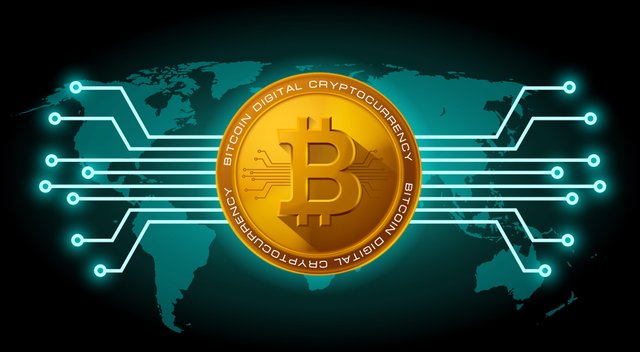The bitcoin, between the pitch and the blowout!
Long Island Iced Tea, an unprofitable American beverage company, decided in mid-December to rename itself Long Blockchain. He would continue to make iced tea, but, as he announced that day, he was going to focus his efforts on exploring the opportunities of the blockchain, the technology that serves as the basis for the bitcoin digital currency. The effect was immediate. Their shares were revalued by 500%. The rise was not explained either by the entry of a new and powerful investor or by a relevant change in the product: there was only one change of name that brought a patina of modernity.
 This is only the penultimate example of the phenomenon of the year in the markets: the craze for bitcoin, which turns what it touches into gold. Despite the warnings from economists and regulators that everything that goes up tends to go down, 2017 was the year of the best-known cryptocurrency, which on January 1 was worth less than $ 1,000 and yesterday was around 14,000. Miners, blockchain or ICO are some terms that in these 365 days have gone from being managed only by a few geeks to become popular.
This is only the penultimate example of the phenomenon of the year in the markets: the craze for bitcoin, which turns what it touches into gold. Despite the warnings from economists and regulators that everything that goes up tends to go down, 2017 was the year of the best-known cryptocurrency, which on January 1 was worth less than $ 1,000 and yesterday was around 14,000. Miners, blockchain or ICO are some terms that in these 365 days have gone from being managed only by a few geeks to become popular.

How long the 'boom'? It seems evident that an asset that has revalued more than 1,400% in a year, and that has lived days of infarction - with vertiginous rises and falls - is subject to strong speculative movements not attributable to its intrinsic value. So the relevant question is not whether there is a bubble, but when it will burst. Here are answers for all tastes. Bitcoin lovers believe that there is still room for growth, and that the fact that they were born with a limit of 21 million coins - still not reached - will encourage their growth. Others are more pessimistic. "We observed classic bubble symptoms. A trigger for your puncture could be a government action. From a public point of view, it is better to end the bubbles sooner rather than later, "Citi warned last week in a devastating report with everything that surrounds bitcoin. "It has a big bubble part. But there is another part that we do not understand, because we do not have parameters or historical experience to analyze decentralized currencies, "says Carlos Kuchkovsky of BBVA.
The chain of blocks.
It is the origin of everything. Bitcoin would not exist without the technology created in 2008 by Satoshi Nakamoto, the pseudonym of one or several people of whom nothing is known. But at the same time, the blockchain is much more than the bitcoin. A growing number of companies are studying the possibilities of this decentralized accounting book that is updated before its millions of users. So none can falsify it unilaterally and all actions are recorded. Sectors such as banking, insurance, telephony operators or even public administrations analyze their possibilities to lighten processes.
"Stupid fraud". "It's worse than tulip fraud. It will not end well. Someone is going to be killed. " Who said these words in September was not just anyone. Jamie Dimon, president of JP Morgan and the most powerful banker of Wall Street, sent himself at ease against the bitcoin, which he called "fraud", of "stupid"; and he said he would fire every minute employee who invested in the digital currency. His comments caused a small earthquake that temporarily lowered the price of bitcoin. But since that day, its value has multiplied by three.
Three letters are worth millions.
Much less known than bitcoin, the Initial Coin Offering (ICO) is perhaps an even more relevant phenomenon than the digital currency. These operations launched by companies to obtain financing in exchange for tokens - units of a digital currency created for this purpose - have achieved so far this year more than 5,700 million dollars (about 4,800 million euros). The HDAC firm, backed by the South Korean multinational Hyundai, has just obtained 258 million dollars. These offers, halfway through a crowdfunding operation and an IPO, have raised alarm among regulators due to their high speculative level. China banned them in September, and countries like Russia are considering imposing limits, especially on unskilled investors. In most of Europe they float in the limbo of the alegalidad. In the CNMV they admit to give "great attention" to some operations that are taking place, of which they warn of their "complexity and high level of risk". Sources of the organism remember that they urge investors to act "with the utmost caution".
The miners of the 21st century.
Fortune hunters today no longer look for gold nuggets like in the mid-nineteenth century California. Now they do it with powerful computers. Bitcoins, unlike traditional currencies, are not issued, but discovered. These new miners obtain digital currencies in exchange for solving mathematical problems that require machines capable of making very fast accounts by trying numbers at random. The increasing number of miners in search of reward has increased competition; a competition that requires increasingly complex and expensive equipment. To gain power, mining farms have been born, most of them in China, which consume enormous energy capacities. Viruses that deal with mining in other people's computers have also been developed.
20,000 or 14,000 dollars?
2017 has shown clearly the immense volatility of bitcoin. It is not only that its value has multiplied by 14 since the beginning of the year. Is that by looking only the last 15 days, the price has fallen by 30%. The decline yesterday, which came down from $ 14,000, is explained by the plans of the South Korean government against speculation and fraud around cryptocurrency through measures such as the prohibition of anonymous transactions or the closure of some digital currency exchange houses. The authorities in Seoul have been trying to reduce bitcoin fever for a long time in a country where, according to a recent survey, one in three employees invests in cryptocurrencies. It is impossible to predict if bitcoin will recover -or surpass- the $ 20,000 ceiling reached in mid-December; but it does seem evident that the cryptocurrency revolution is not a passing storm, and it is here to stay.
Thank you for reading and Follow me ;)
This is definitely something that kind of worries me. It's pretty clear the blockchain concept is revolutionary and valuable, but there is so much mindless money pumping into it, it's difficult to determine where the actual value lines up with how much money people are pumping into it. Now, I don't think the investment money that has come in necessarily beats the actual value, but I do think it has outpaced the implementation of the technology, and it very well might result in a big pushback that takes months if not years of stagnation before the usefulness of the technology is back in line with its price.
This post has received a 5.54 % upvote from @booster thanks to: @sweetiebo.
@sweetiebo payed 1.0 SBD to @minnowbooster to buy a stealth upvote.

transaction-id 20ae15859b82b1f60db7dd31304d3738c7750a62
@stealthgoat
Thanks gor sharing your insights man. A lot of information here! I believe bitcoin will have an interesting year in 2018, being the most volatile year yet. As for it being a bubble I cant see it ever completely bursting. I don't hold or trade BTC because its a coin that's served its purpose and is only spreading FUD to the rest of the technology in the crypto space
Yeah I heard this. Interesting concept, if only that was all it took to run a successful venture long term. Who would've thought short term volatility and wild swings in public sentiment could be involved with a producer of alcohol.